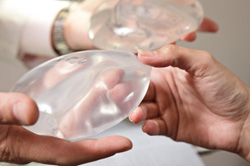Types of Breast Implants
On this page:
- Saline-Filled Breast Implants
- Silicone-Filled Breast Implants
- Summary Breast Implants Safety Information
- Breast Tissue Expanders
- More Information about Breast Implants
Saline-Filled Breast Implants
Saline-filled breast implants contain a silicone outer shell filled with a sterile saltwater (saline) solution. Some are pre-filled and others are filled during the implant operation. Saline-filled implants come in different sizes and have either smooth or textured shells. The FDA approved saline-filled breast implants for breast augmentation in women age 18 or older and for breast reconstruction in women of any age. They are also used in revision surgeries, which correct or improve the result of an original surgery.
Silicone-Filled Breast Implants
Silicone gel-filled breast implants have a silicone outer shell that is filled with silicone gel. They come in different sizes and have either smooth or textured shells.
Silicone gel-filled breast implants are approved for breast augmentation in women age 22 or older and for breast reconstruction in women of any age. They are also used in revision surgeries, which correct or improve the result of an original surgery.
Summary Breast Implants Safety Information
Breast implants are not lifetime devices. The longer a woman has implants, the more likely it is that she will need to have surgery to remove or replace them. The most frequent complications and adverse outcomes experienced by breast implant patients include capsular contracture, reoperation, and implant removal (with or without replacement). Other common complications include implant rupture with deflation, wrinkling, asymmetry, scarring, pain, and infection. In addition, women with breast implants may have a very low but increased likelihood of being diagnosed with anaplastic large cell lymphoma (ALCL).
Magnetic resonance imaging (MRI) continues to be the most effective method of detecting silent rupture of saline- and silicone gel-filled breast implants.
There is no apparent association between saline- and silicone gel-filled breast implants and connective tissue disease, breast cancer, or reproductive problems. However, to rule out these and other complications, studies would need to be much larger and longer than those conducted so far.
In June 2011, the FDA issued an Update on the Safety of Silicone Gel-Filled Breast Implants. This update included preliminary results of the studies required by the manufacturers at the time of approval as well as a review of other available scientific data.
The Summary of Safety and Effectiveness for each of the FDA-approved saline- and silicone gel filled breast implants details safety information known at the time of FDA approval. As the FDA learns of new safety information, it requires companies to update their product labeling. The most current safety information about saline- and silicone gel-filled breast implants can be found in the labeling.
Breast Tissue Expanders
Breast reconstruction may be performed after mastectomy, to rebuild injured or congenitally deformed breasts, or as part of reassignment surgery. As part of the reconstruction process, a breast tissue expander may be used to stretch the patient's tissue for insertion of an implant or the patient's own tissue. Tissue expanders are like thick-walled silicone balloons, come in different sizes and shapes, and may have a smooth or textured outer surface. They are implanted under the breast skin, tissue, or chest muscle, and are regulated by the FDA as medical devices. In immediate reconstruction, the expander is inserted immediately following mastectomy. For patients who choose delayed reconstruction, the expander is implanted in a separate surgery months or years later.
Once the surgical incision is healed, the tissue expander is "inflated" during the course of weeks to months. Inflation may be through a series of saline solution injections at the health care provider's office, or through a patient-controlled device that releases carbon dioxide gas into the expander.
Because expanders are temporary medical devices, an expander is not intended to remain in place for more than six months. When expansion is complete, a new surgical procedure is performed to remove the expander and insert a breast implant or the patient's own tissue.
There are some risks in using tissue expanders. The use of tissue expanders may result in breast tissue injury and skin thinning, pain, especially during saline filling, and infection. The expander may rupture, and the site or port for saline injection may become infected.
More Information about Breast Implants
- What to Know About Breast Implants
- FDA Medical Device Safety Communication: Reports of Anaplastic Large Cell Lymphoma (ALCL) in Women with Breast Implants
- Executive Summary: An Update on the Safety of Silicone Gel-Filled Breast Implants
- Update on the Safety of Silicone Gel-Filled Breast Implants: FDA White Paper (PDF - 1.5MB)
- Anaplastic Large Cell Lymphoma (ALCL) In Women with Breast Implants: Preliminary FDA Findings and Analyses
- Risks of Breast Implants

